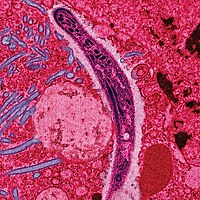
Photo from wikipedia
Abstract In traditional phase 3 trials confirming safety and efficacy of new treatments relative to a comparator, a 1-sided type I error rate of 2.5% is traditionally used and typically… Click to show full abstract
Abstract In traditional phase 3 trials confirming safety and efficacy of new treatments relative to a comparator, a 1-sided type I error rate of 2.5% is traditionally used and typically leads to minimum sizes of 300–600 subjects per study. However, for rare pathogens, it may be necessary to work with data from as few as 50–100 subjects. For areas with a high unmet need, there is a balance between traditional type I error and power and enabling feasible studies. In such cases, an alternative 1-sided alpha level of 5% or 10% should be considered, and we review herein the implications of such approaches. Resolving this question requires engagement of patients, the medical community, regulatory agencies, and trial sponsors.
Journal Title: Open Forum Infectious Diseases
Year Published: 2022
Link to full text (if available)
Share on Social Media: Sign Up to like & get
recommendations!